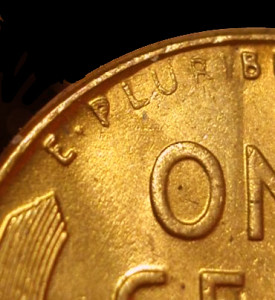Part IV. Die Errors:
Die Damage:
Accidental Die Abrasion
Definition: Abrasion to the die face that occurs by accident. The abrasion can occur in a single incident or may be the result of continual scraping of the die face against a machine part (like a feeder). As with intentional die abrasion, the chief result is a localized lowering of the die face which may remove shallowly recessed design elements. Accidental die abrasion is often accompanied by die scratches or die scrapes. These are generally straight, relatively wide, and rather uniform in appearance. Die scratches caused by intentional die abrasion are much finer and often point in many different directions, although there are exceptions, especially among recent issues like Sacagawea dollars.
 This 1998-P quarter dollar shows accidental die abrasion affecting the area around Washington’s eye and nose. Areas of shallow relief, like the medial corner of the eye, have been lost. Coarse, straight, parallel die scrapes run through the affected area. The damage was most likely inflicted by a mis-timed feeder.
This 1998-P quarter dollar shows accidental die abrasion affecting the area around Washington’s eye and nose. Areas of shallow relief, like the medial corner of the eye, have been lost. Coarse, straight, parallel die scrapes run through the affected area. The damage was most likely inflicted by a mis-timed feeder.

The reverse face of this 1944 cent shows an area of accidental die abrasion that approximates the shape of a right triangle. Enough metal was removed from the die face to create a distinct rise on the coin’s surface which almost swallows up the letters LURI of PLURIBUS. Die damage of this type — both unilateral and bilateral — occurs in the same area in Lincoln cents that date from 1917 to 1945. The repetitive nature and consistent appearance of the damage strongly indicates a machine part is responsible. While a feeder is a likely candidate, the theory has yet to be proven. Damage in this area can take the form of abrasion, a die dent, or a combination of both types of errors.